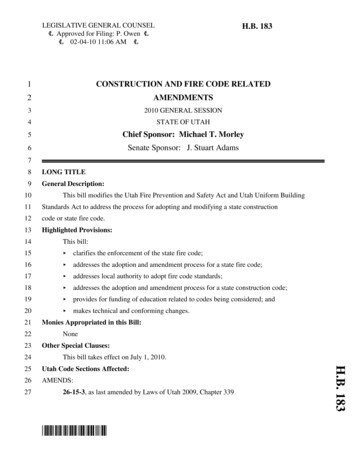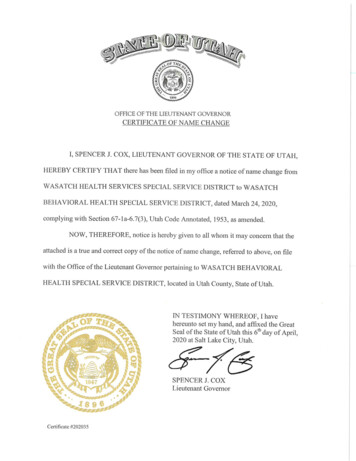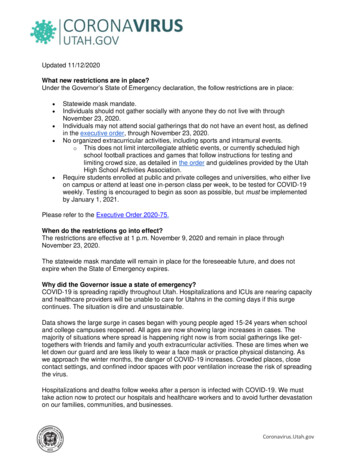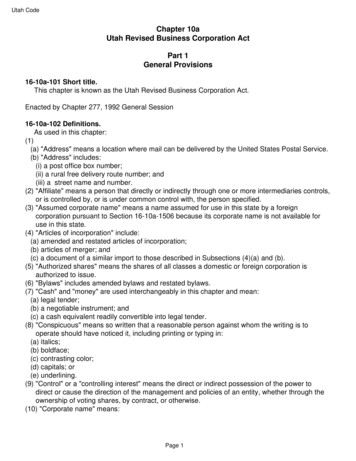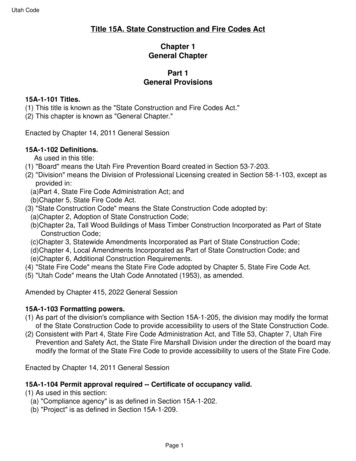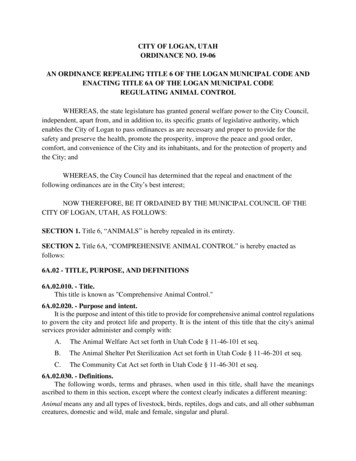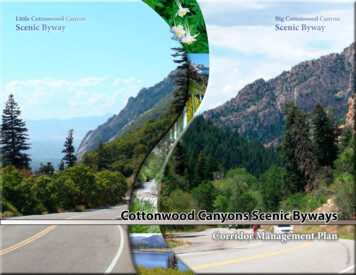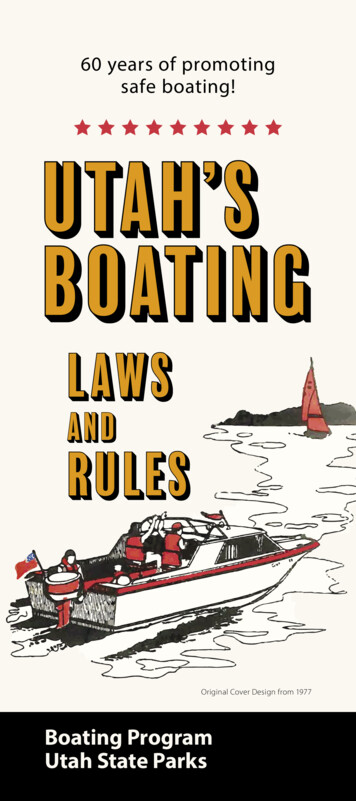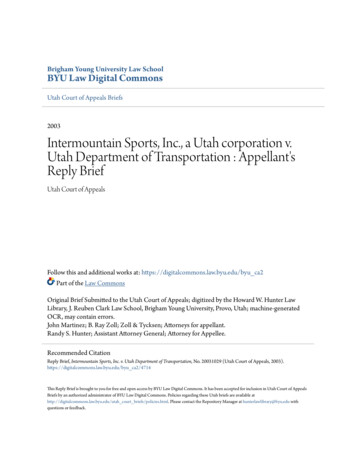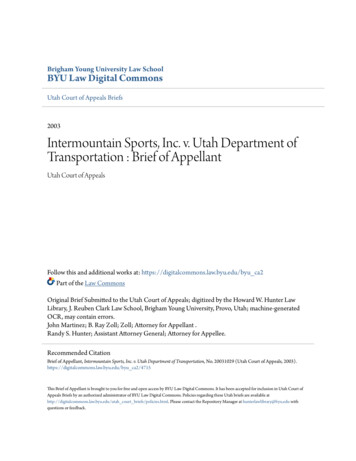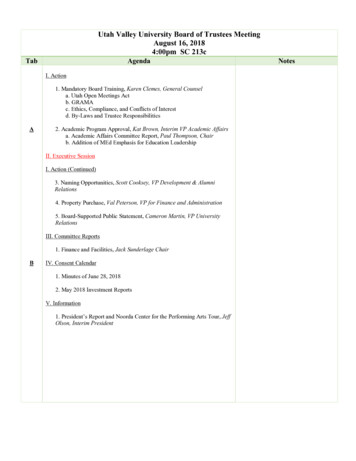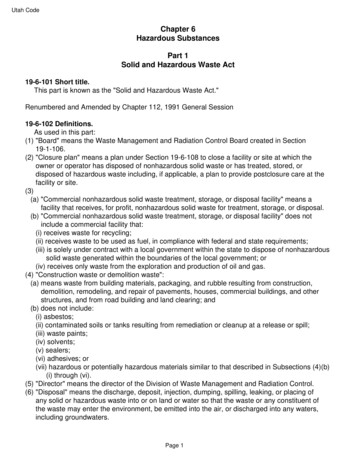
Transcription
Utah CodeChapter 6Hazardous SubstancesPart 1Solid and Hazardous Waste Act19-6-101 Short title.This part is known as the "Solid and Hazardous Waste Act."Renumbered and Amended by Chapter 112, 1991 General Session19-6-102 Definitions.As used in this part:(1) "Board" means the Waste Management and Radiation Control Board created in Section19-1-106.(2) "Closure plan" means a plan under Section 19-6-108 to close a facility or site at which theowner or operator has disposed of nonhazardous solid waste or has treated, stored, ordisposed of hazardous waste including, if applicable, a plan to provide postclosure care at thefacility or site.(3)(a) "Commercial nonhazardous solid waste treatment, storage, or disposal facility" means afacility that receives, for profit, nonhazardous solid waste for treatment, storage, or disposal.(b) "Commercial nonhazardous solid waste treatment, storage, or disposal facility" does notinclude a commercial facility that:(i) receives waste for recycling;(ii) receives waste to be used as fuel, in compliance with federal and state requirements;(iii) is solely under contract with a local government within the state to dispose of nonhazardoussolid waste generated within the boundaries of the local government; or(iv) receives only waste from the exploration and production of oil and gas.(4) "Construction waste or demolition waste":(a) means waste from building materials, packaging, and rubble resulting from construction,demolition, remodeling, and repair of pavements, houses, commercial buildings, and otherstructures, and from road building and land clearing; and(b) does not include:(i) asbestos;(ii) contaminated soils or tanks resulting from remediation or cleanup at a release or spill;(iii) waste paints;(iv) solvents;(v) sealers;(vi) adhesives; or(vii) hazardous or potentially hazardous materials similar to that described in Subsections (4)(b)(i) through (vi).(5) "Director" means the director of the Division of Waste Management and Radiation Control.(6) "Disposal" means the discharge, deposit, injection, dumping, spilling, leaking, or placing ofany solid or hazardous waste into or on land or water so that the waste or any constituent ofthe waste may enter the environment, be emitted into the air, or discharged into any waters,including groundwaters.Page 1
Utah Code(7) "Division" means the Division of Waste Management and Radiation Control, created inSubsection 19-1-105(1)(d).(8) "Generation" or "generated" means the act or process of producing nonhazardous solid orhazardous waste.(9)(a) "Hazardous waste" means a solid waste or combination of solid wastes other than householdwaste that, because of its quantity, concentration, or physical, chemical, or infectiouscharacteristics may cause or significantly contribute to an increase in mortality or an increasein serious irreversible or incapacitating reversible illness or may pose a substantial presentor potential hazard to human health or the environment when improperly treated, stored,transported, disposed of, or otherwise managed.(b) "Hazardous waste" does not include those wastes listed in 40 C.F.R. Sec. 261.4(b).(10) "Health facility" means a:(a) hospital;(b) psychiatric hospital;(c) home health agency;(d) hospice;(e) skilled nursing facility;(f) intermediate care facility;(g) intermediate care facility for people with an intellectual disability;(h) residential health care facility;(i) maternity home or birthing center;(j) free standing ambulatory surgical center;(k) facility owned or operated by a health maintenance organization;(l) state renal disease treatment center, including a free standing hemodialysis unit;(m) the office of a private physician or dentist whether for individual or private practice;(n) veterinary clinic; or(o) mortuary.(11) "Household waste" means any waste material, including garbage, trash, and sanitary wastesin septic tanks, derived from households, including single-family and multiple-family residences,hotels and motels, bunk houses, ranger stations, crew quarters, campgrounds, picnic grounds,and day-use recreation areas.(12) "Infectious waste" means a solid waste that contains or may reasonably be expectedto contain pathogens of sufficient virulence and quantity that exposure to the waste by asusceptible host could result in an infectious disease.(13) "Manifest" means the form used for identifying the quantity, composition, origin, routing, anddestination of hazardous waste during its transportation from the point of generation to the pointof disposal, treatment, or storage.(14) "Mixed waste" means material that is a hazardous waste as defined in this chapter and is alsoradioactive as defined in Section 19-3-102.(15) "Modification request" means a request under Section 19-6-108 to modify a permittedfacility or site for the purpose of disposing of nonhazardous solid waste or treating, storing, ordisposing of hazardous waste.(16) "Operation plan" or "nonhazardous solid or hazardous waste operation plan" means a plan orapproval under Section 19-6-108, including:(a) a plan to own, construct, or operate a facility or site for the purpose of transferring, treating, ordisposing of nonhazardous solid waste or treating, storing, or disposing of hazardous waste;(b) a closure plan;Page 2
Utah Code(c) a modification request; or(d) an approval that the director is authorized to issue.(17) "Permit" includes an operation plan.(18) "Permittee" means a person who is obligated under an operation plan.(19)(a) "Solid waste" means garbage, refuse, sludge, including sludge from a waste treatment plant,water supply treatment plant, or air pollution control facility, or other discarded material,including solid, liquid, semi-solid, or contained gaseous material resulting from industrial,commercial, mining, or agricultural operations and from community activities.(b) "Solid waste" does not include solid or dissolved materials in domestic sewage or in irrigationreturn flows or discharges for which a permit is required under Title 19, Chapter 5, WaterQuality Act, or under the Water Pollution Control Act, 33 U.S.C. Sec. 1251 et seq.(c) "Solid waste" does not include metal that is:(i) purchased as a valuable commercial commodity; and(ii) not otherwise hazardous waste or subject to conditions of the federal hazardous wasteregulations, including the requirements for recyclable materials found at 40 C.F.R. 261.6.(20) "Solid waste management facility" means the same as that term is defined in Section19-6-502.(21) "Storage" means the actual or intended containment of solid or hazardous waste either on atemporary basis or for a period of years in such a manner as not to constitute disposal of thewaste.(22)(a) "Transfer" means the collection of nonhazardous solid waste from a permanent, fixed,supplemental collection facility for movement to a vehicle for movement to an offsitenonhazardous solid waste storage or disposal facility.(b) "Transfer" does not mean:(i) the act of moving nonhazardous solid waste from one location to another location on the sitewhere the nonhazardous solid waste is generated; or(ii) placement of nonhazardous solid waste on the site where the nonhazardous solid waste isgenerated in preparation for movement off that site.(23) "Transportation" means the off-site movement of solid or hazardous waste to any intermediatepoint or to any point of storage, treatment, or disposal.(24) "Treatment" means a method, technique, or process designed to change the physical,chemical, or biological character or composition of any solid or hazardous waste so as toneutralize the waste or render the waste nonhazardous, safer for transport, amenable forrecovery, amenable to storage, or reduced in volume.(25) "Underground storage tank" means a tank that is regulated under Subtitle I of the ResourceConservation and Recovery Act, 42 U.S.C. Sec. 6991 et seq.Amended by Chapter 424, 2022 General Session19-6-102.1 Treatment or disposal -- Exclusions.As used in Subsections 19-6-108(3)(b), 19-6-108(3)(c)(ii)(B), and 19-6-119(1)(a), the term"treatment or disposal" specifically excludes the recycling, use, reuse, or reprocessing of:(1) fly ash waste, bottom ash waste, slag waste, or flue gas emission control waste generatedprimarily from the combustion of coal or other fossil fuels;(2) waste from the extraction, beneficiation, and processing of ores and minerals; orPage 3
Utah Code(3) cement kiln dust, including recycle, reuse, use, or reprocessing for road sanding, sand blasting,road construction, railway ballast, construction fill, aggregate, and other construction-relatedpurposes.Amended by Chapter 256, 2020 General SessionAmended by Chapter 354, 2020 General Session19-6-103 Waste Management and Radiation Control Board -- Members -- Terms -Organization -- Meetings -- Per diem and expenses.(1) The board consists of the following 12 members:(a) the following non-voting member, except that the member may vote to break a tie votebetween the voting members:(i) the executive director; or(ii) an employee of the department designated by the executive director; and(b) the following 11 voting members appointed by the governor with the advice and consent ofthe Senate in accordance with Title 63G, Chapter 24, Part 2, Vacancies:(i) one representative who is:(A) not connected with industry; and(B) a Utah-licensed professional engineer;(ii) two government representatives who do not represent the federal government;(iii) one representative from the manufacturing, mining, or fuel industry;(iv) one representative from the private solid or hazardous waste disposal industry;(v) one representative from the private hazardous waste recovery industry;(vi) one representative from the radioactive waste management industry;(vii) one representative from the uranium milling industry;(viii) one representative from the public who represents:(A) an environmental nongovernmental organization; or(B) a nongovernmental organization that represents community interests and does notrepresent industry interests;(ix) one representative from the public who is trained and experienced in public health and alicensed:(A) medical doctor; or(B) dentist; and(x) one representative who is:(A) a medical physicist or a health physicist; or(B) a professional employed in the field of radiation safety.(2) A member of the board shall:(a) be knowledgeable about solid and hazardous waste matters and radiation safety andprotection as evidenced by a professional degree, a professional accreditation, ordocumented experience;(b) be a resident of Utah;(c) attend board meetings in accordance with the attendance rules made by the departmentunder Subsection 19-1-201(1)(d)(i)(A); and(d) comply with all applicable statutes, rules, and policies, including the conflict of interest rulesmade by the department in accordance with Subsection 19-1-201(1)(d)(i)(B) and the conflictof interest provisions described in Title 63G, Chapter 24, Part 3, Conflicts of Interest.(3) No more than six of the appointed members may be from the same political party.(4)Page 4
Utah Code(a) Members shall be appointed for terms of four years each.(b) Notwithstanding the requirements of Subsection (4)(a), the governor shall, at the time ofappointment or reappointment, adjust the length of terms to ensure that the terms of boardmembers are staggered so that half of the appointed board is appointed every two years.(5) Each member is eligible for reappointment.(6) Board members shall continue in office until the expiration of their terms and until theirsuccessors are appointed, but not more than 90 days after the expiration of their terms.(7) When a vacancy occurs in the membership for any reason, the replacement shall be appointedfor the unexpired term by the governor, after considering recommendations of the board andwith the advice and consent of the Senate.(8) The board shall elect a chair and vice chair on or before April 1 of each year from itsmembership.(9) A member may not receive compensation or benefits for the member's service, but may receiveper diem and travel expenses in accordance with:(a) Section 63A-3-106;(b) Section 63A-3-107; and(c) rules made by the Division of Finance pursuant to Sections 63A-3-106 and 63A-3-107.(10)(a) The board shall hold a meeting at least once every three months including one meetingduring each annual general session of the Legislature.(b) Meetings shall be held on the call of the chair, the director, or any three of the members.(11) Six members constitute a quorum at any meeting, and the action of the majority of memberspresent is the action of the board.Amended by Chapter 352, 2020 General SessionAmended by Chapter 373, 2020 General Session19-6-104 Powers of board -- Creation of statewide solid waste management plan.(1) The board shall:(a) survey solid and hazardous waste generation and management practices within this stateand, after public hearing and after providing opportunities for comment by local governmentalentities, industry, and other interested persons, prepare and revise, as necessary, a wastemanagement plan for the state;(b) promote the planning and application of resource recovery systems to prevent theunnecessary waste and depletion of natural resources;(c) meet the requirements of federal law related to solid and hazardous wastes to ensure that thesolid and hazardous wastes program provided for in this part is qualified to assume primacyfrom the federal government in control over solid and hazardous waste;(d)(i) require a facility, including a facility listed in Subsection (1)(d)(ii), to submit plans,specifications, and other information required by the board to the director beforeconstruction, modification, installation, or establishment of a facility to allow the director todetermine whether the proposed construction, modification, installation, or establishment ofthe facility will be in accordance with rules made under this part;(ii) consider a facility referred to in Subsection (1)(d)(i) to include an incinerator that is intendedfor disposing of nonhazardous solid waste;(iii) consider a facility referred to in Subsection (1)(d)(i) to not include a commercial facility thatis solely for the purpose of recycling, reuse, or reprocessing the following waste:Page 5
Utah Code(A) fly ash waste;(B) bottom ash waste;(C) slag waste; or(D) flue gas emission control waste generated primarily from the combustion of coal or otherfossil fuels; and(iv) consider a facility referred to in Subsection (1)(d)(i) to not include a facility when thefollowing waste is generated and the disposal occurs at an on-site location owned andoperated by the generator of the waste:(A) waste from the extraction, beneficiation, and processing of ores and minerals listed in 40C.F.R. 261.4(b)(7)(ii); or(B) cement kiln dust; and(e) to ensure compliance with applicable statutes and rules:(i) review a settlement negotiated by the director in accordance with Subsection 19-6-107(3)(a)that requires a civil penalty of 25,000 or more; and(ii) approve or disapprove the settlement described in Subsection (1)(e)(i).(2) The board may:(a)(i) hold a hearing that is not an adjudicative proceeding; or(ii) appoint a hearing officer to conduct a hearing that is not an adjudicative proceeding; or(b) advise, consult, cooperate with, or provide technical assistance to another agency of the stateor federal government, another state, an interstate agency, an affected group, an affectedpolitical subdivision, an affected industry, or other person in carrying out the purposes of thispart.(3)(a) The board shall establish a comprehensive statewide waste management plan.(b) The plan shall:(i) incorporate the solid waste management plans submitted by the counties;(ii) provide an estimate of solid waste capacity needed in the state for the next 20 years;(iii) assess the state's ability to minimize waste and recycle;(iv) evaluate solid waste treatment, disposal, and storage options, as well as solid waste needsand existing capacity;(v) evaluate facility siting, design, and operation;(vi) review funding alternatives for solid waste management; and(vii) address other solid waste management concerns that the board finds appropriate for thepreservation of the public health and the environment.(c) The board shall consider the economic viability of solid waste management strategies beforeincorporating the solid waste management strategies into the plan and shall consider theneeds of population centers.(d) The board shall review and modify the comprehensive statewide solid waste managementplan no less frequently than every five years.(4)(a) The board shall determine the type of solid waste generated in the state and tonnage ofsolid waste disposed of in the state in developing the comprehensive statewide solid wastemanagement plan.(b) The board shall review and modify the inventory no less frequently than once every fiveyears.(5) Subject to the limitations contained in Subsection 19-6-102(19)(c), the board shall establishsiting criteria for nonhazardous solid waste disposal facilities, including incinerators.Page 6
Utah Code(6) The board may not issue, amend, renew, modify, revoke, or terminate any of the following thatare subject to the authority granted to the director under Section 19-6-107:(a) a permit;(b) a license;(c) a registration;(d) a certification; or(e) another administrative authorization made by the director.(7) A board member may not speak or act for the board unless the board member is authorized bya majority of a quorum of the board in a vote taken at a meeting of the board.Amended by Chapter 256, 2020 General SessionAmended by Chapter 354, 2020 General Session19-6-105 Rules of board.(1) The board may make rules in accordance with Title 63G, Chapter 3, Utah AdministrativeRulemaking Act:(a) establishing minimum standards for protection of human health and the environment,for the storage, collection, transport, transfer, recovery, treatment, and disposal of solidwaste, including requirements for the approval by the director of plans for the construction,extension, operation, and closure of solid waste disposal sites;(b) identifying wastes that are determined to be hazardous, including wastes designated ashazardous under Sec. 3001 of the Resource Conservation and Recovery Act of 1976, 42U.S.C., Sec. 6921, et seq.;(c) governing generators and transporters of hazardous wastes and owners and operatorsof hazardous waste treatment, storage, and disposal facilities, including requirements forkeeping records, monitoring, submitting reports, and using a manifest, without treating highvolume wastes such as cement kiln dust, mining wastes, utility waste, gas and oil drillingmuds, and oil production brines in a manner more stringent than they are treated underfederal standards;(d) requiring an owner or operator of a treatment, storage, or disposal facility that is subject toa plan approval under Section 19-6-108 or that received waste after July 26, 1982, to takeappropriate corrective action or other response measures for releases of hazardous waste orhazardous waste constituents from the facility, including releases beyond the boundaries ofthe facility;(e) specifying the terms and conditions under which the director shall approve, disapprove,revoke, or review hazardous wastes operation plans;(f) governing public hearings and participation under this part;(g) establishing standards governing underground storage tanks and aboveground petroleumstorage tanks, in accordance with Title 19, Chapter 6, Part 4, Underground Storage Tank Act;(h) relating to the collection, transportation, processing, treatment, storage, and disposal ofinfectious waste in health facilities in accordance with the requirements of Section 19-6-106;(i) defining closure plans, modification requests, or both for hazardous waste, as class I, class Iwith prior director approval, class II, or class III;and(j) prohibiting refuse, offal, garbage, dead animals, decaying vegetable matter, or organic wastesubstance of any kind to be thrown, or remain upon or in a street, road, ditch, canal, gutter,public place, private premises, vacant lot, watercourse, lake, pond, spring, or well.Page 7
Utah Code(2) If any of the following are determined to be hazardous waste and are therefore subjected tothe provisions of this part, the board shall, in the case of landfills or surface impoundmentsthat receive the solid wastes, take into account the special characteristics of the wastes, thepractical difficulties associated with applying requirements for other wastes to the wastes, andsite-specific characteristics, including the climate, geology, hydrology, and soil chemistry at thesite, if the modified requirements assure protection of human health and the environment andare no more stringent than federal standards applicable to waste:(a) solid waste from the extraction, beneficiation, or processing of ores and minerals, includingphosphate rock and overburden from the mining of uranium;(b) fly ash waste, bottom ash waste, slag waste, and flue gas emission control waste generatedprimarily from the combustion of coal or other fossil fuels; and(c) cement kiln dust waste.(3) The board shall establish criteria for siting commercial hazardous waste treatment, storage,and disposal facilities, including commercial hazardous waste incinerators. Those criteria shallapply to any facility or incinerator for which plan approval is required under Section 19-6-108.Amended by Chapter 202, 2021 General Session19-6-106 Rulemaking authority and procedure.(1) Except as provided in Subsection (2), no rule which the board makes for the purpose of thestate administering a program under the federal Resource Conservation and Recovery Act and,to the extent the board may have jurisdiction, under the federal Comprehensive EnvironmentalResponse, Compensation and Liability Act, or the federal Emergency Planning and CommunityRight to Know Act of 1986, may be more stringent than the corresponding federal regulationswhich address the same circumstances. In making the rules, the board may incorporate byreference corresponding federal regulations.(2) The board may make rules more stringent than corresponding federal regulations for thepurposes described in Subsection (1), only if it makes a written finding after public commentand hearing and based on evidence in the record that corresponding federal regulations arenot adequate to protect public health and the environment of the state. Those findings shallbe accompanied by an opinion referring to and evaluating the public health and environmentalinformation and studies contained in the record which form the basis for the conclusion.Renumbered and Amended by Chapter 112, 1991 General Session19-6-107 Director -- Appointment -- Powers.(1) The executive director shall appoint the director. The director shall serve under theadministrative direction of the executive director.(2) The director shall:(a) issue an order necessary to enforce this part;(b) enforce an order by appropriate administrative and judicial proceedings;(c) institute judicial proceedings to secure compliance with this part;(d) carry out inspections pursuant to Section 19-6-109;(e) require submittal of specifications or other information relating to hazardous waste plans forreview, and approve, disapprove, revoke, or review the plans;(f) develop programs for solid waste and hazardous waste management and control within thestate;Page 8
Utah Code(g) advise, consult, and cooperate with another agency of the state, the federal government,another state, an interstate agency, an affected group, an affected political subdivision, anaffected industry, or other affected person in furtherance of the purposes of this part;(h) subject to the provisions of this part, enforce rules made or revised by the board through theissuance of orders;(i) review plans, specifications or other data relative to solid waste and hazardous waste controlsystems or any part of the systems as provided in this part;(j) under the direction of the executive director, represent the state in matters pertaining tointerstate solid waste and hazardous waste management and control including, under thedirection of the board, entering into interstate compacts and other similar agreements; and(k) as authorized by the board and subject to the provisions of this part, act as executivesecretary of the board under the direction of the chair of the board.(3) The director may:(a) subject to Subsection 19-6-104(1)(e), settle or compromise any administrative or civil actioninitiated to compel compliance with this part and any rules adopted under this part;(b) employ full-time employees necessary to carry out this part;(c) authorize any employee or representative of the department to conduct inspections aspermitted in this part;(d) encourage, participate in, or conduct studies, investigations, research, and demonstrationsrelating to solid waste and hazardous waste management and control necessary for thedischarge of duties assigned under this part;(e) collect and disseminate information relating to solid waste and hazardous waste managementcontrol; and(f) cooperate with any person in studies and research regarding solid waste and hazardouswaste management and control.Amended by Chapter 256, 2020 General Session19-6-108 New nonhazardous solid or hazardous waste operation plans for facility or site -Approval required -- Exemptions from legislative and gubernatorial approval -- Time periodsfor review -- Information required -- Other conditions -- Automatic revocation of approval -Periodic review.(1) For purposes of this section, the following items shall be treated as submission of a newoperation plan:(a) the submission of a revised operation plan specifying a different geographic site than apreviously submitted plan;(b) an application for modification of a commercial hazardous waste incinerator if the constructionor the modification would increase the hazardous waste incinerator capacity above thecapacity specified in the operation plan as of January 1, 1990, or the capacity specified inthe operation plan application as of January 1, 1990, if no operation plan approval has beenissued as of January 1, 1990;(c) an application for modification of a commercial nonhazardous solid waste incinerator ifthe construction of the modification would cost 50% or more of the cost of constructionof the original incinerator or the modification would result in an increase in the capacityor throughput of the incinerator of a cumulative total of 50% above the total capacity orthroughput that was approved in the operation plan as of January 1, 1990, or the initialapproved operation plan if the initial approval is subsequent to January 1, 1990;Page 9
Utah Code(d) an application for modification of a commercial nonhazardous solid or hazardous wastetreatment, storage, or disposal facility, other than an incinerator, if the modification would beoutside the boundaries of the property owned or controlled by the applicant, as shown in theapplication or approved operation plan as of January 1, 1990, or the initial approved operationplan if the initial approval is subsequent to January 1, 1990; or(e) a submission of an operation plan to construct a facility, if previous approvals of the operationplan to construct the facility have been revoked pursuant to Subsection (3)(c)(iv) or (v).(2) Capacity under Subsection (1)(b) shall be calculated based on the throughput tonnagespecified for the trial burn in the operation plan or the operation plan application if no operationplan approval has been issued as of January 1, 1990, and on annual operations of 7,000 hours.(3)(a)(i) Except as specified in Subsection (3)(a)(ii)(C), a person may not own, construct, modify,or operate a facility or site for the purpose of transferring, treating, or disposing ofnonhazardous solid waste or treating, storing, or disposing of hazardous waste without firstsubmitting and receiving the approval of the director for an operation plan for that facility orsite.(ii)(A) A permittee who is the current owner of a facility or site that is subject to an operation planmay submit to the director information, a report, a plan, or other request for approval for aproposed activity under an operation plan:(I) after obtaining the consent of any other permittee who is a current owner of the facility orsite; and(II) without obtaining the consent of any other permittee who is not a current owner of thefacility or site.(B) The director may not:(I) withhold an approval of an operation plan requested by a permittee who is a currentowner of the facility or site on the grounds that another permittee who is not a currentowner of the facility or site has not consented to the request; or(II) give an approval of an operation plan requested by a permittee who is not a currentowner before receiving consent of the current owner of the facility or site.(C) A facility referred to in Subsection (3)(a)(i) does not include a facility when the waste fromthe extraction, beneficiation, and processing of ores and minerals listed in 40 C.F.R. Sec.261.4(b)(7)(ii), or cement kiln dust, is generated and the disposal occurs at an on-sitelocation owned and operated by the generator of the waste.(b)(i) Except for a facility that receives the following wastes solely for the purpose of recycling,reuse, or reprocessing, a person may not own, construct, modify, or operate anycommercial facility that accepts for treatment or disposal, with the intent to make a profit,any of the wastes listed in Subsection (3)(b)(ii) without first submitting a request to andreceiving the approval of the director for an operation plan for that facility site.(ii) Wastes referred to in Subsection (3)(b)(i) are:(A) fly ash waste, bottom ash waste, slag waste, or flue gas emission control waste generatedprimarily from the combustion of coal or other fossil fuels;(B) wastes from the extraction, benef
Hazardous Substances Part 1 Solid and Hazardous Waste Act 19-6-101 Short title. This part is known as the "Solid and Hazardous Waste Act." Renumbered and Amended by Chapter 112, 1991 General Session 19-6-102 Definitions. As used in this part: (1) "Board" means the Waste Management and Radiation Control Board created in Section 19-1-106.
